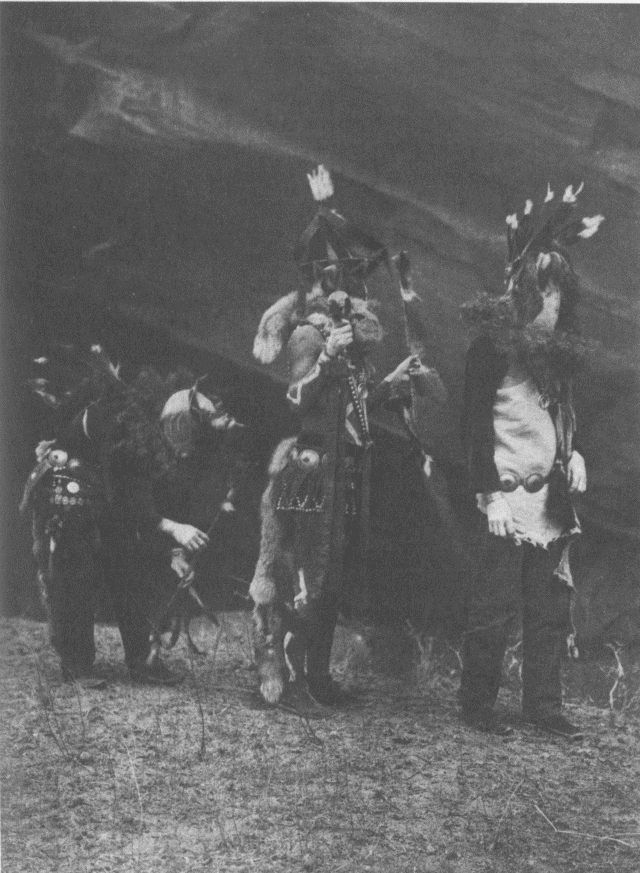A description of the ritual and form of the Yébîchai ceremony,—Kléjê Hatál, or Night Chant,—covering its nine days of performance, will give a comprehensive idea of all Navaho nine-day ceremonies, which combine both religious and medical observances. The myth characters personified in this rite are termed Yébîchai, Grandfather or Paternal Gods. Similar personifications appear in other ceremonies, but they figure less prominently
Note: The use of the word “Navaho”, and , “Navajo” are used in the writings about the Diné, their history, and culture. See this article: Use and spelling Navaho or Navajo
Each morning during the first four days of the Navaho Yébîchai healing ceremony, or Night Chant, the patient is sweated—sometimes inside a small sweat-lodge, oftener by being placed upon a spot previously heated by a fire and covered with heavy blankets.
The three figures are medicine-men, or singers, chanting. The patient lies under the blankets surrounded by a line of sacred meal in which turkey-feather prayer-sticks, kadán, are implanted.
First Day:
The ceremonial, or medicine, hogán is built some days in advance of the rite. The first day’s ceremony is brief, with few participants. Well after dark the singer, assisted by two men, makes nine little splint hoops entwined with slip-cords, and places them on the sacred meal in the meal basket.
CIRCLE KETHAWNS.
These objects, called by the various but nearly synonymous names of Ye’b’tsai-tsa’pas, ye’ts-ida-V’lpas, ye’bapas and tsapasiazi-olia’l, are twelve in number. Each circle is made of a twig of ts’i’lts’ln or aromatic sumac two spans long.
The ends are tied together by means of a yucca fiber exactly two spans long. The butt end of the fiber is applied to the. butt end of the twig, underneath it, and at first parallel to it, the fiber is’ then wound around the spliced extremities of the twig, so that its tip end shall approximate the tip end of the’ twig
Following this, three men remove their everyday clothing, take Yébîchai masks, and leave the hogán. These three masked figures are to represent the gods Haschéltî, Talking God, Haschbaád, Goddess, and Haschélapai, Gray God.
When they have gone and passed to the rear of the hogán, the patient comes in, disrobes at the left of the center, passes around the small fire burning near the entrance of the hogán, and takes his seat in the center, immediately after which the singing begins.
During the third song Hasché?lt? enters with his cross-sticks—Hasché?lt? balíl—and opens and places them over the patient’s body, forcing them down as far toward the ground as possible. The second time he places them not so far over the body; the third, not lower than the shoulders; the fourth time, over the head only, each time giving his peculiar call, Wu-hu-hu-hu-u!
Then Hasché?lt? takes up a shell with medicine and with it touches the patient’s feet, hands, chest, back, right shoulder, left shoulder, and top of head, this being the prescribed ceremonial order, uttering his cry at each placing of the medicine.
He next places the shell of medicine to the patient’s lips four times and goes out, after which Hasch?baád comes in, takes one of the circle k?dán, touches the patient’s body in the same ceremonial order, and finally the lips, at the same time giving the slip-cord a quick pull.
Next comes Hasché?lapai, who performs the same incantations with the k?dán. Again Hasché?lt? enters with the cross-sticks, repeating the former order, after which he gives the patient four swallows of medicine,—a potion different from that first given, the medicine-man himself drinking what remains in the shell. This closes the ceremony of the first day.
There will, perhaps, be considerable dancing outside the hogán, but that is merely practice for the public dance to be given on the ninth night. The singer and the patient sleep in the hogán each night until the nine days are passed, keeping the masks and medicine paraphernalia between them when they sleep.
SONGS OF THE EVENING
The songs sung on this evening, called Aga’hoa’gis-in or Summit Songs, are 26 in number; but not all are sung on this occasion; more of them are heard later during the nine-days’ ceremony. The whole set is sung on the third night. When there is no dance of the naakhai’ to be held on the last night, only three songs of the set -are repeated.
The personated deities pictured in this plate appear together in acts of succor in the Night Chant in the order seen, the Talking God in the lead. From left to right they are, respectively, the God of Harvest, Fringe Mouth, and Talking God.
Sources of Information for the Article:
The Night Chant, A Navaho Ceremony. By Washington Matthews – May, 1902.
Legend Of The Night Chant- The North American Indian By Edward S. Curtis 1907
The Nightway:A History and a History of Documentation of a Navajo Ceremonial by: James C. Faris – 1990.
Earth is My Mother, Sky is my Father, by Trudy Griffin-Pierce, 1992


